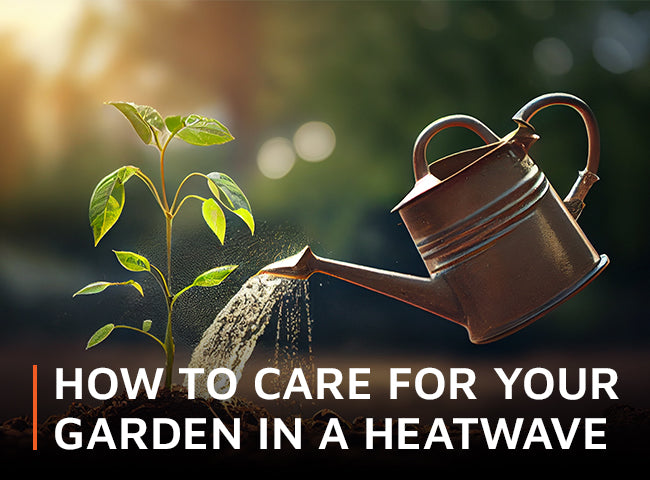As much as we Brits enjoy a spot of sunshine, prolonged periods of heat can have a devastating effect on your garden. But there’s no need to despair for your greenery when a heatwave is forecast - there are a few things you can do to give your garden the best chances of survival.
Smart watering

Image source: Marbury via Getty Images.
Being smart with your watering will be key to get your garden through the hot weather. Water earlier in the morning, when there’s less likelihood of the water evaporating as soon as you’ve doused it on your plants. Potted plants will need to be watered more frequently than your flowerbeds; you can leave water in pot saucers for them to drink throughout the day.
It’s better to give your soil a thorough soaking, allowing the water to permeate the soil. A light surface watering encourages roots to stay close to the topsoil and therefore will be more likely to burn or wither in the heat. Soak your soil every few days instead of surface watering daily - you can test whether the soil needs watering by putting your finger in the top few centimetres. If it’s dry, it needs a good soaking. Lock in all that moisture with mulch.
To create even more effective watering, scrape soil around your plants to create ‘bowls’ for you to water into. Alternatively, use old pots or bottles partially sunk into the soil, and water into those. This way water will go directly to the roots where your plants need it most. Hosepipe ban? No problem. Avoid watering your lawn, and instead focus on your plants and beds - hoses may be banned, but you can still use a good old fashioned watering can.
Recently established plants will need more water than already established plants - these can probably survive a few days without water, if you’re limited by how much water you can offer your garden. Make good use of water butts in your garden or even recycle old, cool bathwater, too - but make sure to use this on veg you'll have to wash before eating.
Be generous with mulching

Image source: Hans Verburg via Getty Images.
Generously mulch your plant beds after watering to retain as much moisture in the soil as physically possible. By covering the surface with mulch, you can prevent the plant roots from burning, and it will act as insulation to lock in all that precious moisture you’ve worked hard to get into the soil. Don’t forget to mulch your potted plants, too.
Create mulches from organic material such as grass clippings, leaves, and compost. You can even create a living mulch with exuberant sprawling plants such as squashes, which will naturally shade the soil.
Shade plants as much as possible

Image source: mofles via Getty Images.
Shade is important for plant survival. Move as many of your potted plants into a shaded area if you can; while they won’t grow as well in the shade, the cooler temperatures will reduce the amount of heat stress inflicted on them. If there are little to no shady areas in your garden, you can create shade by using shade netting, or even by hanging old netted curtains across them.
Cool-season plants like strawberries, lettuces, and cabbages will be especially grateful for any shade relief you can offer them.
Don’t fertilise plants or your lawn
When you fertilise your lawn and plants, the abundance of nutrients signals to your greenery that it’s time to start growing again. Plants need more water to process all the extra fertiliser, which will have a detrimental effect on them during periods of drought.
A lot of plants like tomatoes will curl up their leaves during heatwaves to reduce water loss. They can sometimes lose their flowers or stop producing new flowers and fruit in an attempt to preserve water sources. By pausing with your fertiliser, you’ll be giving them a chance to conserve as much energy as they can to survive the hot weather. Instead, focus on watering them correctly to give them the moisture they need to stay alive.
Harvest your plants promptly

Image source: Zbynek Pospisil via Getty Images.
If your plants have got ripe fruits or foliage that’s ready to be harvested, then harvest it as soon as you can. This way your plants will have fewer things to focus their energy on and can instead worry about keeping the rest of it alive. This will save them energy in the long run, and your plants will resume their normal productivity once the heatwave is over.
You should also avoid cutting your lawn. Leave the grass as long as possible, ideally around 3”, so as to create more shade for the soil. While the grass may wither away under the heat, it will gladly bounce back again once the rain returns. For other lawn care tips, check out our ultimate lawn care guide.
Avoid unnecessary digging

Image source: AlexRaths via Getty Images.
There should be less need to dig when heatwaves hit, as any plants you transplant will find it difficult to establish themselves in the soil due to a lack of moisture. Not only that - when you dig, you’re making the soil more likely to lose moisture through evaporation. By avoiding digging during heatwaves, you’ll be ensuring that the soil doesn’t suffer more water loss than it would do normally.
There’s no need to panic when that heatwave hits - follow these simple rules, and your garden should be able to pull through the heat with no issues. Are there any tips you think we’ve missed that will help your garden during a heatwave? Let us know over on our Facebook page!
Lead image: eag1e via Getty Images.




